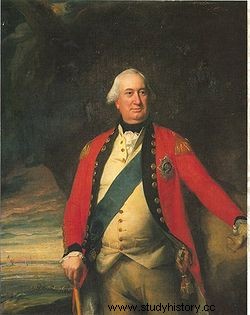
Charles Cornwallis, 1st Marquess Cornwallis, born December 31, 1738 in London (Grosvenor Square) and died October 5, 1805 in Gauspur near Ghazipur in northern India1 was a British general known as commander of British troops during the siege of Yorktown during the American Revolutionary War. Subsequently, he was Governor General of India (1786-1793) and Lord Lieutenant of Ireland (1798-1801) before being the main British negotiator of the Treaty of Amiens (1802).
Eldest son of Charles, fifth Baron Cornwallis, he was educated at Eton and Cambridge. He obtained an officer's commission (Ensign) in 1757 before obtaining permission to continue his military studies in Turin.
Joining the British troops during the Seven Years' War, he participated in the battles of Minden, Villinghausen, Wilhelmsthal and Lutzelberg as well as the siege of Cassel.
Elected to the House of Commons in 1760, then to the House of Lords in 1762, he was - paradoxically, in view of his future role during the American Revolutionary War - one of the five to vote against the Stamp Duty (Stamp Act (1765).
He married in 1768 Jemima Tullekin Jones. The couple had two children, a boy and a girl before Jemima's death in 1779.
Appointed major-general in 1775 then lieutenant-general in 1777, he played a major role in the American Revolutionary War by fighting the insurgents. He won the Battle of Camden on August 16, 1780 over the troops of General Horatio Gates but was defeated by the troops of Washington and Rochambeau (supported by a French fleet commanded by Admiral de Grasse) at the Battle of Yorktown (September- October 1781).
This battle decided the fate of the war and the independence of the United States, ratified in the Treaty of Paris (1783).
Despite his defeat, he was appointed Commander-in-Chief in India and Governor-General of Bengal and issued a series of regulations known as the Cornwallis Code. He defeated Sultan Tippu's troops in the third of Mysore's four wars.
As Lord Lieutenant of Ireland and Commander-in-Chief, he repelled a French invasion in August 1798 and subsequently played an important role in the passing of the Act of Union (1800) which united Ireland with Great Britain giving birth to the United Kingdom of Great Britain and Ireland before resigning in protest at King George III's refusal to grant political rights to Irish Catholics.
As Minister Plenipotentiary, he led the British representation during the negotiations which led to the Peace of Amiens2, concluded on March 25, 1802.
He returned to India where he died shortly after arriving at Gauspur near Ghazipur (where his mausoleum can still be seen today) in 1805.
His letters were published by Charles Ross, 3 volumes in-8, London, 1859.
